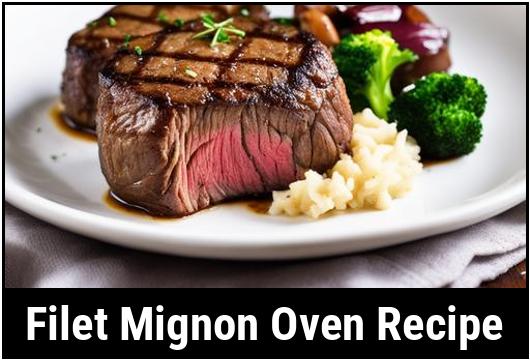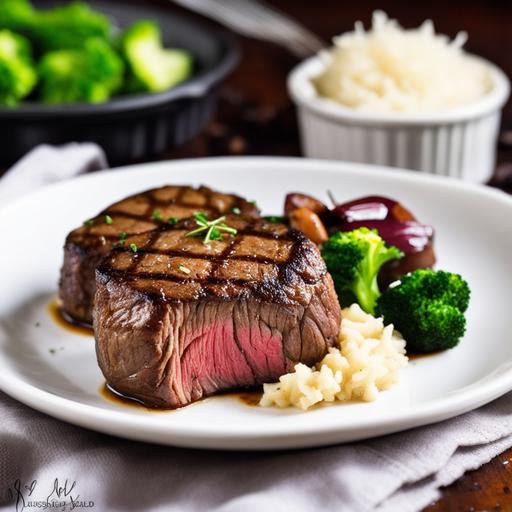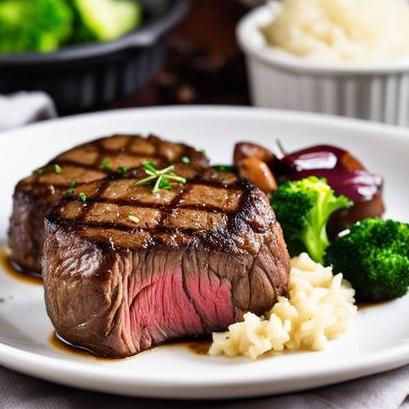
Filet Mignon Oven Recipe: A Comprehensive Guide
Welcome to the wonderful world of filet mignon! In this comprehensive and in-depth article, we will explore the food science, culinary details, selection, cleaning, preparation, tips, variations, doneness checks, and of course, an amazing filet mignon oven recipe. So grab your apron, and let’s dive into the juicy details!
The Food Science Behind Filet Mignon
Filet mignon, also known as the "king of steaks," is a highly prized cut of beef from the tenderloin. Its exceptional tenderness and buttery texture can be attributed to two factors: the location of the muscle and the amount of work it does.
The tenderloin muscle is located near the spine in the loin section of the cow. Due to its minimal weight-bearing function, this muscle is not as developed as others, resulting in its remarkable tenderness. Additionally, the tenderloin is predominantly composed of fine muscle fibers and intramuscular fat, further enhancing its luxurious mouthfeel.
Selecting the Perfect Filet Mignon
When it comes to choosing filet mignon, quality matters. Look for cuts that exhibit a deep red color with marbling throughout. Marbling refers to the thin lines of fat that run through the meat, enhancing both flavor and juiciness. Aged filet mignon (typically aged for at least 21 days) is preferred as it tenderizes the meat and intensifies its flavor.
Make sure the filet mignon is well-shaped and firm to the touch. Avoid any cuts with an excessive amount of sinew or excessive surface fat. Remember, we are aiming for an exceptionally tender and succulent experience!
Cleaning and Preparation

Proper cleaning and preparation are essential to ensure the best cooking outcome for your filet mignon. Follow these steps to prepare your filet mignon before cooking:
-
Remove the filet mignon from its packaging and gently pat it dry with paper towels. This step helps in achieving a good sear later on.
-
Trim off any excess fat or sinew, if desired. Some people prefer keeping a thin layer of fat for additional flavor during the cooking process, but it is entirely up to your personal taste.
-
Season the filet mignon generously with salt and pepper. This simple seasoning mixture allows the natural flavors of the meat to shine.
Remember, proper handling and cleanliness are crucial during preparation to prevent any foodborne illnesses. Wash your hands thoroughly and sanitize all utensils and surfaces that come in contact with raw meat.
Tips for Achieving Perfection
To ensure a sublime filet mignon experience, consider the following tips:
-
Let it rest: Before cooking, allow the filet mignon to sit at room temperature for about 30 minutes. This step promotes even cooking and tenderness throughout the meat.
-
Preheat the oven: Make sure your oven is preheated to the desired temperature (discussed later) before placing the filet mignon inside for a consistent and controlled cooking process.
-
Use a heavy-bottomed skillet or cast-iron pan: These types of pans provide excellent heat distribution and retention, allowing for a perfect sear on your filet mignon.
-
Don’t forget the oil: Use a high smoke-point oil like grapeseed or canola oil to coat the pan before searing. This prevents the meat from sticking and aids in achieving a beautiful crust.
-
Invest in a meat thermometer: To achieve the desired level of doneness, a meat thermometer is your best friend. It ensures your filet mignon is cooked to perfection without overcooking.
Variations and Doneness Checks

Filet mignon can be cooked to various levels of doneness, depending on your preference. Here are the most common levels of doneness and their associated temperatures:
-
Rare: 120°F (49°C) – 125°F (52°C)
-
Medium Rare: 130°F (54°C) – 135°F (57°C)
-
Medium: 140°F (60°C) – 145°F (63°C)
-
Medium Well: 150°F (66°C) – 155°F (68°C)
-
Well Done: 160°F (71°C) and above
Remember to insert the meat thermometer into the thickest part of the filet mignon without touching bone or fat. This ensures an accurate reading of the internal temperature.
The Filet Mignon Oven Recipe
Now, it’s time to put all the knowledge into action with our mouthwatering filet mignon oven recipe. Follow these steps for a delectable dining experience:
Ingredients:
-
2 filet mignon steaks (1 ½ – 2 inches thick)
-
Salt and pepper, to taste
-
2 tablespoons of high-smoke point oil (grapeseed or canola)
Instructions:
-
Preheat your oven to 425°F (218°C).
-
Season both sides of the filet mignon generously with salt and pepper, pressing the seasoning into the meat.
-
Heat a heavy-bottomed skillet or cast-iron pan over medium-high heat and add the oil.
-
Once the oil is shimmering, carefully place the filet mignon steaks in the hot pan. Sear for 2-3 minutes on each side until a beautiful golden-brown crust forms.
-
Transfer the seared filet mignon to a baking sheet or oven-safe dish and place it in the preheated oven.
-
Cook to the desired level of doneness, checking the internal temperature with a meat thermometer. Remember to aim for an ideal temperature based on your preference.
-
Remove the filet mignon from the oven and let it rest for 5-10 minutes. Resting allows the juices to redistribute, resulting in a moist and flavorful steak.
-
Serve your perfectly cooked filet mignon with your favorite sides, such as roasted potatoes or sautéed vegetables. Pair it with a red wine of your choice for a truly delightful meal.
Avoiding Overcooking and Undercooking
Achieving the perfect level of doneness can be a delicate balance. Overcooking can result in a dry and tough filet mignon, while undercooking can leave you with an unpleasant rawness. To avoid these pitfalls, follow these additional tips:
-
Use the touch test: By pressing the center of the filet mignon with your finger, you can assess the level of doneness. The firmer the meat, the closer it is to being well done. However, this method might take some practice to master.
-
Practice makes perfect: Cooking filet mignon to perfection might require some experimentation, as every oven and cut of meat is unique. Keep a record of your cooking times and temperatures to find your sweet spot.
Remember, a slightly undercooked filet mignon can always be cooked further, but unfortunately, an overcooked one is irreversible. So, it’s better to err on the side of caution.
In Conclusion
Filet mignon is truly a delicacy that deserves extra attention and care during preparation and cooking. Understanding the food science behind its tenderness, selecting quality cuts, following proper cleaning and preparation techniques, and mastering the art of achieving the perfect level of doneness are all crucial in creating a memorable filet mignon dining experience.
So, gather your ingredients, sharpen your culinary skills, and get ready to indulge in the heavenly delight that is filet mignon. Enjoy experimenting with flavors, exploring different variations, and most importantly, savoring every tender and succulent bite. Bon appétit!
Sources
FAQS On Filet Mignon Oven Recipe
What Is Filet Mignon?
Filet mignon is a tender cut of steak that comes from the smaller end of the beef tenderloin.
What Temperature Should I Cook Filet Mignon In The Oven?
Preheat your oven to 425°F (218°C) to cook filet mignon. This high temperature is crucial to ensure that the meat’s surface is seared and forms a delicious crust while cooking.
How Long Should I Cook Filet Mignon In The Oven?
The cooking time for filet mignon in the oven depends on the thickness of the steak and how you like your meat cooked. A general guideline is to cook a 1-inch thick filet mignon for 10-12 minutes for medium-rare doneness, and add 2-3 minutes for medium and well-done.
How Do I Season Filet Mignon For Oven Cooking?
Season the filet mignon with a generous amount of salt and black pepper, and add any additional herbs or spices you prefer, such as garlic, thyme, and rosemary. Let the steak rest at room temperature before cooking.
Can I Cook Filet Mignon In A Cast-iron Skillet Instead Of The Oven?
Yes, you can cook filet mignon in a cast-iron skillet on the stovetop. Heat the skillet over high heat until it’s smoking hot, then add the steak and sear for 2-3 minutes on each side until a crust forms. Transfer the skillet to the oven and continue cooking until the desired doneness is reached.



